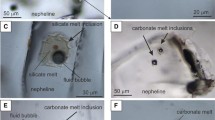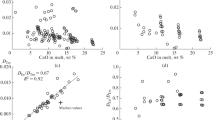Abstract
Experiments in the systems diopside-albite (Di-Ab) and diopside-albite-dolomite (Di-Ab-Dmt), doped with a wide range of trace elements, have been used to characterise the difference between clinopyroxene-silicate melt and clinopyroxene-carbonate melt partitioning. Experiments in Di-Ab-Dmt yielded clinopyroxene and olivine in equilibrium with CO2-saturated dolomitic carbonate melt at 3 GPa, 1375 °C. The experiments in Di-Ab were designed to bracket those conditions (3 GPa, 1640 °C and 0.8 GPa, 1375 °C), and so minimise the contribution of differential temperature and pressure to partitioning. Partition coefficients, determined by SIMS analysis of run products, differ markedly for some elements between Di-Ab and Di-Ab-Dmt systems. Notably, in the carbonate system clinopyroxene-melt partition coefficients for Si, Al, Ga, heavy REE, Ti and Zr are higher by factors of 5 to 200 than in the silicate system. Conversely, partition coefficients for Nb, light REE, alkali metals and alkaline earths show much less fractionation (<3). The observed differences compare quantitatively with experimental data on partitioning between immiscible carbonate and silicate melts, indicating that changes in melt chemistry provide the dominant control on variation in partition coefficients in this case. The importance of melt chemistry in controlling several aspects of element partitioning is discussed in light of the energetics of the partitioning process. The compositions of clinopyroxene and carbonate melt in our experiments closely match those of near-solidus melts and crystals in CMAS-CO2 at 3 GPa, suggesting that our partition coefficients have direct relevance to melting of carbonated mantle lherzolite. Melts so produced will be characterised by elevated incompatible trace element concentrations, due to the low degrees of melting involved, but marked depletions of Ti and Zr, and fractionated REE patterns. These are common features of natural carbonatites. The different behaviour of trace elements in carbonate and silicate systems will lead to contrasted styles of trace element metasomatism in the mantle.
Similar content being viewed by others
Author information
Authors and Affiliations
Additional information
Received: 15 July 1999 / Accepted: 18 February 2000
Rights and permissions
About this article
Cite this article
Blundy, J., Dalton, J. Experimental comparison of trace element partitioning between clinopyroxene and melt in carbonate and silicate systems, and implications for mantle metasomatism. Contrib Mineral Petrol 139, 356–371 (2000). https://doi.org/10.1007/s004100000139
Published:
Issue Date:
DOI: https://doi.org/10.1007/s004100000139




